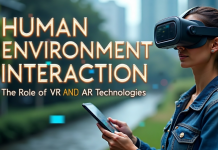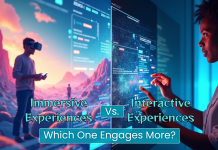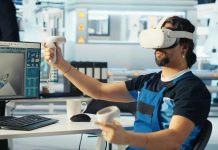The global pandemic forced us to take our operations online, creating a heavy reliance on virtual and immersive digital experiences. Augmented reality (AR) is to thank for the successful transition and growth of these engaging experiences across a variety of industries. Its increasing accessibility has helped this technology become a familiar feature on mobile devices and computers.
Key Takeaways
- The pandemic increased reliance on virtual experiences, leading to growth in industries impacted by Augmented Reality.
- E-commerce now utilizes AR for ‘try before you buy’ experiences, enhancing online shopping confidence.
- In education, AR offers innovative ways to teach complex subjects without the need for physical labs.
- The foodservice industry benefits from AR by creating virtual experiences that enhance customer engagement and showcase skills.
- Industrial sectors leverage AR for supply chain transparency and 3D visualization of complex equipment, fostering innovation.
New industries are taking advantage of it. Four core sectors will be impacted by Augmented Reality, showing rapid growth and adoption of AR in ways that we’ve never seen before. These industries include e-commerce, education, the food service industry, and industrial sectors.
Here’s how:
E-Commerce
As a safety precaution, many people limited their in-store shopping plans this year and instead opted for the e-commerce experience. Online retailers have been and will continue adjusting their online platforms moving into 2021. Their goal is to create more fulfilling shopping experiences. These should come as close to the in-person experience as possible. This helps to increase sales and minimize returns.
Many retailers who have introduced AR-backed 3D models and ads have found it to be useful. It boosts buyer confidence due to the “try before you buy” online shopping experience. Brands such as Ikea and Home Depot have begun using AR to help customers preview their furniture to scale in the safety of their own home. According to a Nielsen global survey from 2019, consumers listed Augmented and Virtual Reality as the top technologies they’re seeking to assist them in their daily lives. Truly, it is impacted by Augmented Reality.
Education
Education was publicly thrust into the public eye as students all across the nation had to switch to virtual learning. As a result, ed-tech Investments are expected to grow by 16.1% a year to reach $181 Bn by 2025. AR emerged as a support for education areas that are challenging to teach in a virtual setting. For example, it’s not easy for students to gain access to labs or the necessary equipment needed for physics, chemistry, and even geology labs.
However, using AR in these labs would not only eliminate the need for expensive supplies and equipment. It would also provide a more personalized teacher-student setting. Students can perform a biology dissection lab without needing to be in the lab, using an AR model. Dissection day is just another way an industry is impacted by Augmented Reality.
Foodservice
The food service industry may have been one of the hardest hit by the pandemic, with many restaurants closing down for good. AR is and will continue to be used to give restaurants access to education for survival. It also helps to create hybrid live/virtual experiences to engage customers from afar. AR will offer foodservice industry professionals opportunities to connect virtually. They can showcase skills and products using AR human hologram-led demonstrations and 3D, volumetric objects. These efforts can drive sales, customer loyalty, and innovation among restaurateurs and vendors. This comes at a time when the industry is feeling the impact of COVID-19.
The use of AR also humanizes and brings to light the people and process behind how food gets from farm or sea to our plates. A report from The Center for Food Integrity (CFI) found that 65% of people want to know more about where their food comes from. Keeping consumers informed will ensure the most frequent and lucrative visitors keep returning to the food outlets they love. Foodservice is truly the most impacted by Augmented Reality.
Industrial
The pandemic created a sense of urgency that accelerated the digital transformation of more industrial industries. As they’ve been forced to accommodate virtual experiences and remote work, they’ve seen firsthand benefits. AR and human holograms open new doors for supply chain transparency, global sales, and industry-focused education. Many of these industries work with large, complex technologies that can now be accessed and viewed in 3D from any mobile device.
However, Holograms used at industrial conventions and events can provide attendees with the ability to see large industrial equipment. These are items that simply could not be brought in as a demonstration at an in-person expo or event.
Impacted by Augmented Reality
Even after the pandemic comes to an end, there will be many industries that continue to use the unique and practical tools that have helped them get back on their feet. These 4 industries impacted by Augmented Reality, specifically, have aided many, transforming into a crucial tool for them all. Additionally, from education to ecommerce, AR has opened up a world of possibilities. It will continue to open up doors for creativity and innovation for years to come.











